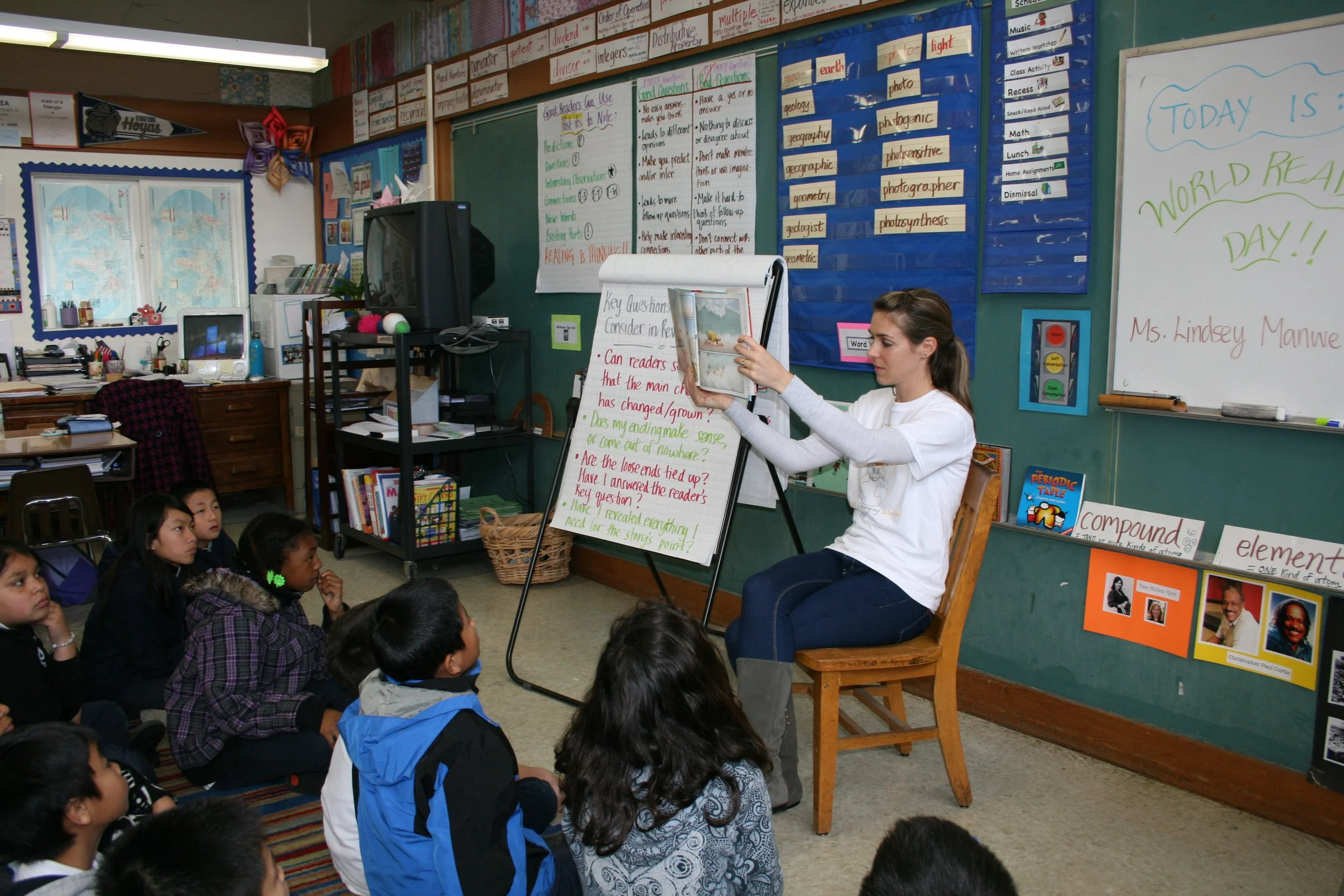Featuring Amber Peterson, Chief Programs Officer at LitWorld
According to data from the National Assessment Governing Board, literacy rates for 4th and 8th grade students in the United States are continuing to decline, a trend that was observed before the pandemic. While this compounding drop in reading scores is troubling, our Chief Programs Officer, Amber Peterson, weighs in on what parents, teachers, and the education system can do to help set students up for success, and why literacy is a critical cornerstone of a healthy society.
Our Chief Programs Officer, Amber Peterson, reading to an eager audience at the Brooklyn Public Library | Photo by Katalina Studios
1. Recent data reveals that literacy rates are on the decline in the United States, especially with 4th and 8th grade students. Why is it critical to ring the alarm on these statistics?
LitWorld champions literacy as a foundational human right because there is a clear correlation between literacy skills and one’s ability to participate fully in social, civic, and professional life. Literacy allows us to tell our stories and to advocate for ourselves and our communities, making it an important tool in the push for equity. Literate communities are also healthier, more resilient, and more prosperous, making the decline in literacy a pressing concern for all of us. Highlighting these statistics helps to emphasize the urgency of this crisis and underscores the need for sustained investment in literacy at local, national, and global levels.
2. Why do you think literacy rates haven’t returned to pre pandemic levels?
The pandemic posed an unprecedented disruption to our way of life and I don’t think any of our social structures came out of it unscathed. It exposed deep inequities long embedded within our education system. Remote learning was a necessary stop gap that was effective for some, but not for others. Access to technology, consistency in the quality of instruction, and parental support varied dramatically across the board. Removing the social scaffolding that schools provide (ie. access to meals, peer interaction, safe spaces) further disrupted the learning process and contributed to the learning loss that we experienced. There’s a very real trauma we’re dealing with in the aftermath of the pandemic and rebuilding from it that will take time, patience, and concerted, collaborative effort.
Photo by Katalina Studios
3. Do you agree that some of the causes for the literacy rate decline is associated with increased screen time (ie. cell phones and social media)?
Yes and no.
Learning how to responsibly balance screen time is something most adults struggle with, and unsurprisingly, our kids aren’t faring any better. So much of our screen time is spent on passive entertainment- it’s designed to be low effort and addictive, and the instant gratification means we don’t have to engage with or work hard for the content we receive. This oversaturation of passive content results in diminished attention spans and detrimental effects on learning.
However, not all digital content is created equal. There are some amazing digital tools and spaces with the capacity to expand our knowledge, our perspectives, and our access to the world. Technology has the ability to break down barriers, connect us across cultures and language, and exercise our creativity in unprecedented ways. If we’re using technology intentionally and prioritizing platforms and tools that encourage active reading, mindful screen use, and immersive practices, then we can set our youth up for success, now and in the future.
For LitWorld, technology has always been the gateway to building global communities. Since 2010, we’ve amassed an international consortium of community based partners through virtual meetings and whatsapp groups. Through Skype, LitKids from Kenya were able to connect with their penpals in India. Webinars and zoom meetings allow us to amplify our partners' work and share critical information. And every World Read Aloud Day, hundreds of millions of people access stories and content through our website and across the internet. Reading aloud is a powerful way to build community, and technology enables us to do that on a global scale.
While technology can feel intimidating as it often evolves faster than we do, it’s here to stay. If we approach it intentionally, our digital world has the potential to become a great equalizer and an invaluable tool for making learning and stories more accessible to all.
Photo by Katalina Studios
4. A 2024 article in The Atlantic suggests that even students at top universities struggle with advanced texts, linking this issue to a decline in high school curriculum rigor. What factors might contribute to this trend, and why?
Since the late 1990s, efforts to norm the educational experience across the country have resulted in an overreliance on standardized testing and the assessment of technical skills and knowledge. While standardized testing has its place, large-scale assessments often fail to capture depth or higher-order thinking skills like creating, evaluating, and analyzing. Because we don’t test for these skills, our focus on them in the classroom becomes inconsistent at best.
Ironically, it’s these higher-order skills that are most essential for post-secondary success. Advanced reading and comprehension require deep analysis and interpretive abilities—skills that students can’t be expected to master in college if they haven’t practiced them beforehand.
To truly prepare students, we must prioritize creativity, critical thinking, and problem solving in their formative classroom experiences. We need to give kids the freedom to take risks, embrace challenges, and work hard to uncover knowledge. Cultivating a culture where failure is seen as an opportunity for growth is key to this process. Failure pushes us to think critically and creatively to find solutions, fostering resilience and deeper learning.
At LitWorld, much of our programming celebrates the idea of failure as a pathway to growth. By encouraging kids to learn from their mistakes and remain resilient, we help them build essential skills that serve them well beyond the classroom. These lessons in creativity, critical thinking, and perseverance are what truly prepare students for success in life.
Photo by Katalina Studios
5. What can parents do to help their children fall in love with reading?
Many studies suggest that one of the greatest gifts we can give our children is a love of reading. Nurturing this love can begin with something as simple and powerful as reading aloud. LitWorld founded World Read Aloud Day to emphasize the profound impact of this accessible practice.
According to research by the University of Melbourne, reading aloud to children daily puts them almost a year ahead of children who do not receive daily read alouds- this is true regardless of income, education level, or cultural background. Beyond its role as a literacy tool, reading aloud is also a powerful social act that fosters connection, builds community, and provides access to diverse stories and perspectives.
Building a culture of literacy begins at home. Start by creating rituals around reading aloud with your family. Whether it’s a bedtime tradition or a breakfast routine, find consistent opportunities to share stories together. Make sure that you provide access to a wide range of books that reflect the richness and diversity of the world. Encourage your children to tell their own stories—giving them the space to express their creativity and share their ideas with an enthusiastic audience.
Most importantly, be joyful about reading! Treat it as an exciting opportunity rather than a chore. Explore books that spark enthusiasm, whether novels, nonfiction, or even comic books. When reading aloud, make the experience lively and fun—use animated voices and embrace your inner thespian. Create a home environment where reading, listening, and storytelling feel safe, joyful, and celebrated.
6. From a systemic perspective, what resources should be put into place?
An African proverb reminds us that "it takes a village to raise a child." Cultivating literate communities takes collaborative, cross-sector investment that starts with ensuring equitable access to education. This includes properly training, supporting, and respecting our teachers—their mental, physical, and financial well-being is vital. We must ensure that our classrooms are equipped with the most effective learning tools and materials, including diverse and engaging libraries that reflect the richness of our histories and the world around us. Moreover, we need funding for initiatives that empower children not only to become readers but to grow into impactful storytellers and changemakers. Achieving this vision requires a united effort from governments, schools, nonprofits, community spaces, and families.
World Read Aloud Day which falls on the first Wednesday of every February (February 4, 2026), is a chance to advocate for the critical role of literacy in our personal, communal, and global well-being. Visit litworld.org to join the celebration and contribute to this important movement. A literate world is a healthier, more connected, and more equitable world.











